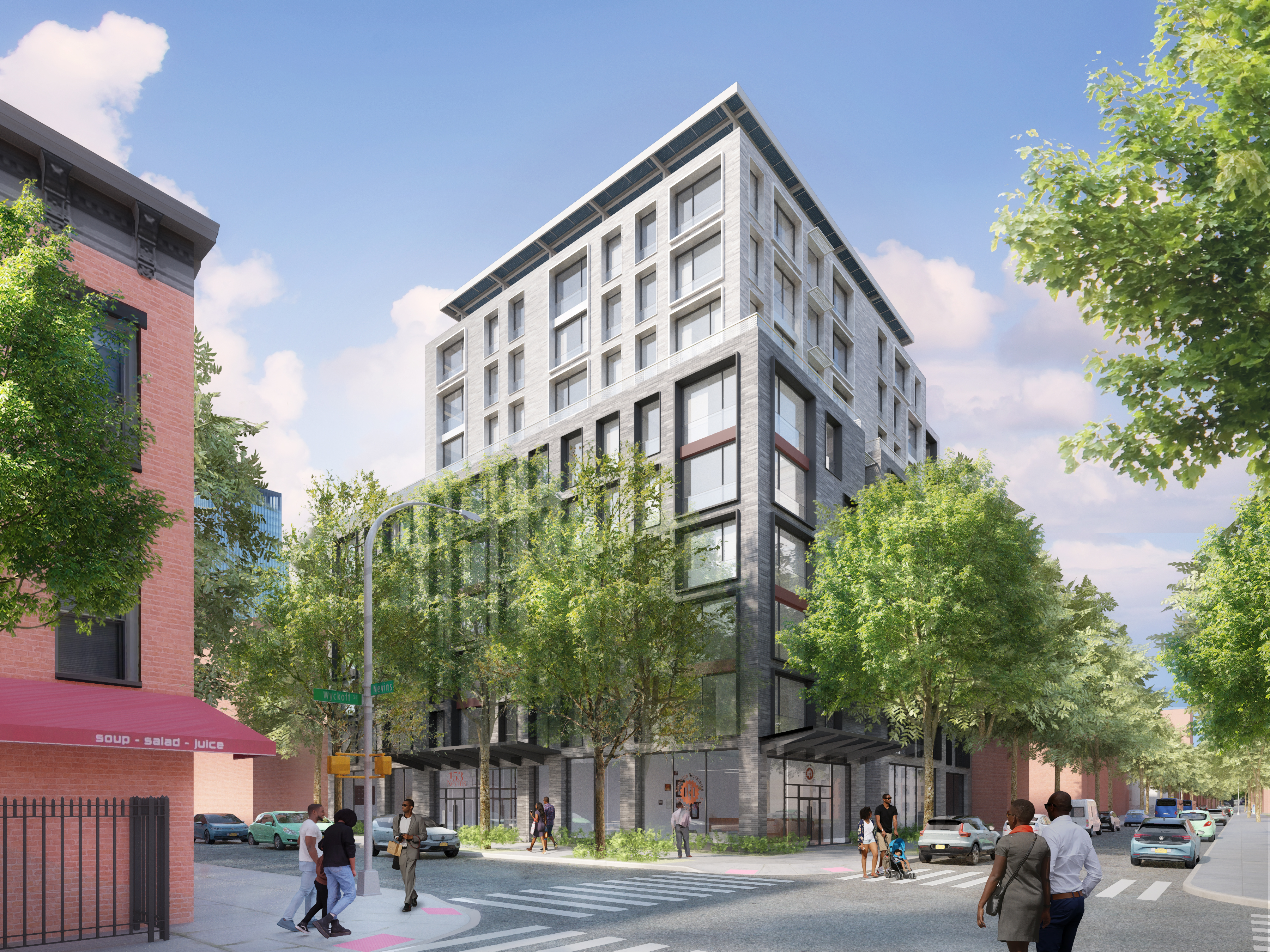Inside Third & Bond: Week 24
Today, the Hudson Companies blogging crew starts to contemplate that ambien of a document, the Offering Plan. In the midst of our multi-tasking and exhaustive Valentine’s Day planning, we are beginning to take time throughout our busy days to begin to cobble together the Condominium Offering Plan (OP), the very thick document each prospective buyer…


Today, the Hudson Companies blogging crew starts to contemplate that ambien of a document, the Offering Plan.
In the midst of our multi-tasking and exhaustive Valentine’s Day planning, we are beginning to take time throughout our busy days to begin to cobble together the Condominium Offering Plan (OP), the very thick document each prospective buyer will receive prior to signing a contract. It can easily take 4-6 months if not longer for the Attorney General’s office to sign-off on an offering plan, and you need an approved OP to legally sell condos. Thus, if you don’t want your salespeople telling excited purchasers that it will only be a few more days until the plan is approved, it’s time to get to work on the OP.
The OP is a compendium of all the aspects of a new condominium that an informed buyer would want to know. Each OP starts off with a Special Risks category, followed by the sales prices, common charge budgets, tax projections, project specifications, floor plans, condominium by-laws, purchasing process and contract, house rules, etc, etc. This document becomes the Bible to interpret all future disputes and disagreements within the condominium, and it’s not uncommon for Condo Board members to be leafing through an old offering plan five years after completion.
Here are some of the issues that arise as we put together the offering plan:
Special Risks: These are the items the AG’s office insists that you discuss with overwhelming clarity (and often capital letters) so that no buyers can say they were unsuspectingly lured into a condo quagmire. Special risks might be: we’re about to build phase 2 and it’s going to block all your views; or there’s a brownfield site next door; or the building is on a ground lease. In the case of Third & Bond, the special risks will be pretty typical and not particularly scary or special, such as: 1) while we plan to get 421-a tax exemption, we can’t represent that we’ll actually have it until HPD approves the application; 2) buyers will pay the transfer taxes on the transaction which, while typical for new construction, is atypical for the marketplace; 3) the neighborhood is being considered for rezoning, which will lead to more people/traffic/less parking, etc. Maybe we’ll add a final one: some of the postings on Brownstoner are pretty obsessed that we’re building on a toxic waste dump.
Common Charge Budget: Since this building doesn’t exist yet, we have to guesstimate what common charges will be, so we’ll be putting a budget together making assumptions for everything from how much the water bill should be to how much we’re paying the super. It’s a balancing act. If we’re too conservative in our budgeting, we may show common charge projections that are too high, or not competitive and displeasing to the eye of our buyers. If we budget on the cheap, we’re left with a bunch of pissed off residents when common charges increase significantly after they move in. In fact, if you’re off by more than 20% in your projections, buyers have the right of recission (aka, we’re outta here, give us our money back).
Common Interest Allocation: Each condo unit has its own common interest percentage which determines its portion of the total common charge. Sponsors have certain latitude to determine the allocation as long as the calculation is consistently applied. And with each project we have the same debates. If we have identical apartments, one on the 2nd floor and one on the 20th floor, do we give them identical common charges since they’re using the building’s services comparably? Or do we skew the allocation so that the 2nd floor unit has a lower common charge and thus becomes a more compelling sale, and the 20th floor unit has a higher common charge, but that’s OK because someone will buy the awesome apartment and won’t care about the extra $50/month in common charges? Again, it’s a balancing act, you don’t want to kill the golden goose condo with too high a common charge allocation, and yet you want to invite buyers to consider your less attractive units with low carrying charges.
Project Specifications: This is a good place to read the fine print to find out everything that’s going to be in the building from the hardware to the fridge to the roof system. We take this section very seriously, because whenever there is a dispute between the Sponsor and a condo, the first thing the pissed-off residents will do is hire an engineer to go through the spec with a fine tooth comb to determine if the Sponsor did not install everything per spec. Mistakes happen constantly: the architect prepares the spec, the contractor installs something different, and the angry residents run to the AG screaming Gotcha!
Condominium By-Laws and House Rules: it’s regrettable, though predictable, that the by-laws, which serve as the constitution for a new building (and can’t be amended without 70% approval of the owners), gets the least attention from both Sponsor and buyer. After all, Sponsors are focused on sales prices, kitchen appliances and getting their OP’s approved, who has time to worry about Roberts Rules of Order? And yet, when everyone meets annually to make a quorum, elect board members, approve alteration packages, etc, everyone dutifully consults the by-laws.
In sum, the offering plan is chock full of information to provide a 300 page caveat emptor. Usually after prospective buyers visit the sales office, we know if they’re serious about purchasing if they write a $100 deposit check to leave the sales office with one of our heavy, bound offering plans. We ask our broker, Did they take the offering plan? At least 50% of the time, our brokers respond, Nah, they wanted us to forward it to their attorney.
Inside Third & Bond: Week 23 [Brownstoner]
Inside Third & Bond: Week 22 [Brownstoner]
Inside Third & Bond: Week 21 [Brownstoner]
Inside Third & Bond: Week 20 [Brownstoner]
From our lawyers: This is not an offering. No offering can be made until an offering plan is filed with the Department of Law of the State of New York.”





I thought you need to get AG approval to even test the market. All this publicity seem to fall in to this other category. Most developers’ and their attorneys are so scared about the AG getting angry about their publicity if they so much as put up a website or put a sign on their building. Is blogging okay with the AG now? I agree this is a fascinating transparent look at what you are going through and all. But does that mean it’s not publicity?
Do I plan to lie when estimating common charges? Definitely, after I finish cheating on my taxes.
It’s not exactly a win-win for a developer to establish artificially low common charges and then deal with angry residents. It sours every other conversation, and I think credibility still counts for something these days.
Most of the line items we don’t even calculate ourselves. The utility expenses are calculated by our engineers using their usage estimates. The insurance estimate is provided by our insurance broker. We focus on staffing & payroll, repairs, maintenance, etc. In fact, if you ask the J Condo residents, we purposefully used conservative union-scale wages in our estimates so that there wouldn’t be an increase if the staff went union.
Finally, if the 421-a process is properly handled, buyers should expect to pay the taxes based on the Schedule A “Taxes with 421-a” and this amount should not change significantly because it should be based on the prior tax assessment from the year prior to the start of construction.
I’ve bought in newish construction twice now, and both times the monthly common charge has doubled within 24 months. The explanation for this, I came to learn, is simple: People buy more new condos more quickly if the monthly charges appear cheap.
I guess I’d lie about this too if I was a developer — you can always just throw up your hands later and say, sorry, we guessed wrong.
Do you plan to lie when estimating your common charges? After all, how many potential buyers would come in and pore over the offering plan and actually know where you radically “underestimated” the costs? Seems like an easy win for the developers here…
Here’s the full law. http://421a.com/421alaw.html
I’m curious about how a 421a works. Moving into a new construction condo in Prospect Heights next month. It’s a 10 unit building built on a vacant lot (Never had any construction on it like a park or business.) I understand the sponsor has to file for a 421a. It seems likely from all the research I’ve done the building will obtain 421a status.
1. Do I have to pay full taxes until the paper work for the 421a is approved? Can we receive a rebate after?
2. Will the percentage of taxes paid change over the years?
I continue to find this process (if not this particular document) fascinating and daunting– really takes balls to develop real estate in this town. Good luck to ya.
how do you estimate common charges? how can you predict what they will be? how can you tell how much fuel and energy a building uses? and don’t energy prices keep going up? also once closing begin is the developer responsible for paying taxes and common charges on unsold units? i bought a condo with a 421a and my taxes tripled shortly after i moved in. our attorneys said the initial estimate was based on pre construction cost of the land and once the building was finished they reassessed it the value was higher. isn’t a 421a supposed to prevent that?